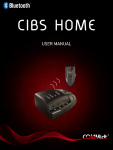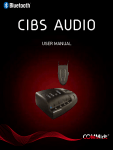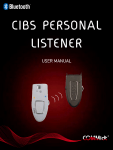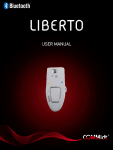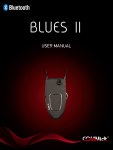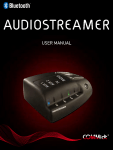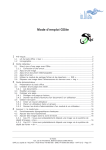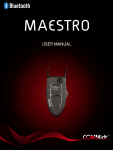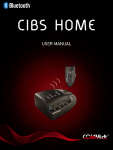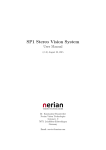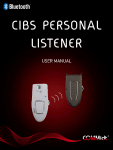Download User Guide - Teltex, Inc.
Transcript
® CIBS TOTAL User manual MAESTRO 5 4 11 6 7 3 2 8 1 12 9 10 1 1 AUDIOSTREAMER 14 13 15 17 16 18 19 2 20 21 22 23 24 25 LIBERTO 29 31 30 28 27 26 33 34 3 32 CIBS TOTAL 4 NO EN F D NL ES SE DK SU All units in this set are ready-paired for your convenience! English Congratulations About CIBS Total ……Maestro (neck loop) ……Audiostreamer (Radio/TV unit) ……Liberto CIBS Total’s functions Charging Maestro and Liberto Assemble Audiostreamer Connection of audio units to Audiostreamer Turn On/Off Maestro and Liberto Pairing units Maestro/Liberto: how to... ……adjust the volume (Maestro) ……adjust the sensitivity/strength of the microphones ……shift between programmes on Maestro ……see which programme Maestro is in ……use the conversation amplifier on Maestro ……listen to audio equipment (TV/Radio, etc.) ……answer a telephone call (Maestro) ……end a telephone call (Maestro) ……make a call (Maestro) ……activate Voice-Dialing (Maestro) ……use Speed-Dial (Maestro) ……switch between microphones (Liberto) ……programme Maestro Switch audio sources on Audiostreamer Meaning of light diodes and colours Factory default ……Maestro ……Audiostreamer Troubleshooting and FAQ Storage and maintenance Certification and safety approvals (english) Declaration of conformity (english) 5 6 6 7 7 8 9 10 11 11 12 12 14 14 14 14 14 14 15 16 16 16 16 17 17 17 17 18 19 19 20 20 21 C D User manual CIBS Total (NO_GB_F_DE_NL_ES_SE_DK_SU) 1i NO Congratulations Congratulations on your new CIBS Total. We hope you will have much joy out of the solution that gives you very good sound from the TV/Radio and that gives you better sound in conversations and in meetings with several participants. This manual will ensure that you get started so that you will get the most possible joy out of your new solution. Your dealer supplies a number of accessories that further expand the functionality of this product. The unit should be charged completely before use (see page 10 for instructions). Charging takes approximately 2 hours. Please note! Together with the connected headset/earbuds the Maestro unit can provide sound at a high volume. Subjecting yourself to this can lead to permanent hearing damage. Be careful when you increase the volume so that you avoid such damage. EN F D NL ES SE DK SU Be careful when using the unit when you are engaged in an activity requiring your full attention. Never attempt to take apart the units yourself. Only approved dealers or service centres may open the product. Contact the dealer if any of the parts of the product must be replaced. Store out of reach of children: Plastic bags that the product and accessories are packaged in are not toys for children. The bags themselves or the small parts they contain can lead to suffocation if they are swallowed. Ignition of flammable atmospheres Do not use the Maestro, Liberto or Audiostreamer in surroundings where there is a danger of ignition of flammable gasses. About CIBS Total CIBS Total consists of 3 units: Maestro (neck loop), Liberto (wireless microphone) and Audiostreamer (wireless transmitter for sound from TV/Radio etc.) Maestro is the main unit in the system. It receives sound from Audiostreamer, Liberto and from your mobile telephone. User manual CIBS Total (NO_GB_F_DE_NL_ES_SE_DK_SU) 1i 6 NO EN Maestro (neck loop) See the illustrations on page 1 for explanation of the points below F • D Answer button 1 : Used to answer incoming telephone calls • Socket for charging and accessories 2 : Input for AC adaptor (accessories) for power socket, and other accessories with 2.5 mm jack plug. • Program indicator (lamps) 3 : Shows which programme Maestro is in. See table on page 19 for explanation of light signals. • USB input 4 : Used for charging of the unit via USB cable to a computer. • Headset output 5 : Can connect the accompanying earbuds with microphone, standard headset (accessories) and headset with microphone (accessories). Used when you are not using hearing aids. • Microphone • Battery indicator lamp 7 : Shows the battery level on Maestro. See table on page 18 for explanation of light signals. • Programme selector 8 : Shifts between the different programmes. • Off/On button 9 . Turns the unit off and on. • Volume button 10 : Slide up to increase sound and down to lower sound. • Pairing button 11 : Sets the Maestro to pairing mode. This has to be done the first time you establish a connection between the devices. • Speed-Dial button 12 : Call up a pre-programmed number from a paired mobile telephone. The number is programmed easily via a computer with Internet access and standard Bluetooth connection. NL ES SE DK SU 6 Audiostreamer (Radio/TV unit) See the illustrations on page 2 for explanation of the points below • 7 Audio source lamps 13 : Shows which audio source is selected (TV, Radio, etc.) User manual CIBS Total (NO_GB_F_DE_NL_ES_SE_DK_SU) 1i NO • Charging station 14 : For charging Maestro and Liberto. • Alerting lamp 15 : Shows if there is an alerting signal on the connected alerting system (see page 17 for explanation of light signal). • Communication lamp 16 : Shows that the unit transmits an audio signal to Maestro. It also shows whether the unit is in pairing mode (see page 18 for explanation of light signal) EN F D NL ES • Audio source buttons 17 : Used to select the audio source (TV, Radio, etc.) SE • Pairing button 18 : Sets Audiostreaner in paring mode DK • Factory setting button 19 : Sets Audiostreamer back to factory settings. SU • Alerting system input 20 : Input for alerting system. • Radio input 21 : Input for stereo/radio or other audio equipment. • TV input 22 : Input for TV/tuner or other audio equipment. • AUX2 input 23 : Input for audio equipment with phono/RCA plugs. • AUX 1 input 24 : Input for IPod/MP3 player or audio equipment with 3.5 mm Jack plug. • Power input 25 : Input for accompanying power supply. Liberto See the illustrations on page 3 for explanation of the points below • Push-to-talk button 26 : Used to establish a connection to Maestro. • Inlet for charging and accessories 27 : Input for AC adaptor (accessories) for power socket, and other accessories with 2.5 mm jack plug. User manual CIBS Total (NO_GB_F_DE_NL_ES_SE_DK_SU) 1i 8 NO EN • Status lamp 28 : Shows whether Liberto communicates with Maestro. See table on page 18 for explanation of the light signals. • Microphone selector 29 : Used to change between the Directional microphone and the Omni microphone (see explanation below) • Battery indicator lamp 30 : Shows the battery level on Liberto. See table on page 18 for explanation of the light signals. • Directional microphone 31 : Captures sound in a certain direction and reduces background noise. • Omni microphone 32 . Captures sound in all directions (360 degrees). • Off/On button 33 . Turns the unit off and on. • Volume button 34 : Used to change the sensitivity/strength of the microphones. F D NL ES SE DK SU All sound from Maestro is only heard if you use the hearing aid/CI in T or MT position and have the loop around the neck, or if earbuds/headset is used. CIBS Total’s functions CIBS Total has 3 main functions: 1. Amplifier for TV/Radio, etc. (TV/RADIO): Transmits sound wirelessly from TV/Radio,etc. via the Audiostreamer to Maestro. You can choose between 4 different audio sources on the Audiostreamer. You can also receive an alert from your alerting system if this has an audio output and is connected to the Audiostreamer. The alerting signal will have the highest priority and will overrule all audio sources and telephone calls. In order to connect audio equipment without Bluetooth you must use COMMidt’s audio cable (accessories, art. no. 908-001) in order to input the sound in Maestro. NOTE! You will not be able to receive an alerting signal on Maestro as long as it has an active audio connection to a Liberto, Allegro or other AD2P-bluetooth products. 9 User manual CIBS Total (NO_GB_F_DE_NL_ES_SE_DK_SU) 1i NO 2. Conversation amplifier (CONVERSATION) In situations where you feel the sound from hearing aids/CI becomes too low or there is too much interference, you use the wireless microphone Liberto or cabled microphones (accessories, these are plugged in to input 2 ). The microphone is placed near the audio source in order to achieve better sound quality. Liberto can also be used as a directional microphone where you point it at the person you want to listen to. 3. Amplifier for telephony (TELEPHONE) Communicates with mobile/cordless/table top telephones with Bluetooth. For table top telephones without Bluetooth use Tango VII (accessory) with Bluetooth for wireless communication between the table top phone and Maestro. Charging Maestro and Liberto Ensure that Maestro and Liberto are charged before you begin using them. You can charge Maestro and Liberto in the following ways: • Through the charger cradle in the Audiostreamer • Direct from a computer with an USB cable • Through the Twin Charger Cradle (accessory) • Through a AC adaptor for power socket (accessory) • Through the car charger (accessory). EN F D NL ES SE DK SU When charging, the battery indicator lamp 7 on Maestro/ 30 on Liberto will blink red. Once Maestro is fully charged, the battery indicator lamp 7 on Maestro/ 30 on Liberto will be illuminated with a constant blue light. In the event of a low battery level, the battery indicator lamp 7 on Maestro/ 30 on Liberto will blink red at the same time as you hear an audio signal on Maestro. To recharge Maestro (without clip) in the Audiostreamer you have to push Maestro down and to the right side in the charging cradle. Push the Maestro down and in toward the centre of the charging cradle to remove the device. To recharge Maestro with the clip you have to you twist the clip upwards (with the opening towards the T- Loop. Push the Maestro down in the charging cradle until you hear a click. Push the Maestro down and then push the clip towards the Maestro to remove the unit from the Audiostreamer. User manual CIBS Total (NO_GB_F_DE_NL_ES_SE_DK_SU) 1i 10 NO EN F D Note: The battery life span will be significantly reduced if the equipment remains uncharged for longer periods. Therefore, we recommend that you charge the equipment at least once per month. When the operating time on the battery begins to decrease and you would like it changed, it must be sent to your local dealer. The article number for the battery is: 956-001 NL ES SE DK SU Assemble Audiostreamer Use the accompanying power supply and put in into the power inlet 25 . The Audiostreamer will then turn on automatically. You will see this by looking at one of the input lamps 13 being illuminated green. The Audiostreamer has no on/off button. It will automatically go in standby mode when it is in use. A removable device is included that allows you to charge Maestro/Liberto both with and without clips in the charging cradle. If you wish to charge them without clips the removable device must be placed down in the charging station, as shown in the picture together with the assembly instructions on page B. If you would like to place the Audiostreamer on the wall, you can use the accompanying brackets. Assembly instructions on page B. Connection of audio units to Audiostreamer The Audiostreamer has 4 audio inlet jacks: • AUX 1 inlet 24 has a 3.5mm Jack plug. Best suited to iPod/MP3 players but you can connect other audio equipment to this jack. • AUX 2 inlet 23 has 2 phono plugs. Here you can connect the desired audio equipment. • TV inlet 22 has 2 phono plugs. Best suited to TV/tuners but you can connect other audio equipment to this inlet. • Radio inlet 21 has 2 phono plugs. Best suited to radio/stereo equipment but you can connect other audio equipment to this inlet. The Audiostreamer has one inlet for alerting system. • Alert system input 20 has a 3.5mm Jack plug. Here you can connect all alerting systems that have an audio output. This is done by using a line cable (accessories). 11 User manual CIBS Total (NO_GB_F_DE_NL_ES_SE_DK_SU) 1i NO Turn On/Off Maestro and Liberto How to turn on Maestro/Liberto: • Press and hold in the On/Off button 9 on Maestro / 33 on Liberto until you see a blue light on the Battery indicator lamp 7 on Maestro 30 on Liberto, at the same time as you hear an audio signal via the T-Loop or via a headset connected to Maestro. How to turn off Maestro/Liberto: • Press and hold in the On/Off button 9 on Maestro / 33 on Liberto until you see a red light on the Battery indicator lamp 7 on Maestro 30 on Liberto, at the same time as you hear an audio signal via the T-Loop or via a headset connected to Maestro. Pairing units Units must be programmed to be able to communicate with each other and with other Bluetooth units (e.g. a mobile phone). This is done by connecting these together wirelessly (pairing). EN F D NL ES SE DK SU NOTE! It is important that Maestro, Audiostreamer, Liberto and other Bluetooth units are within a distance of less than 1 meter during pairing and that the units to be paired are fully charged. All units in CIBS Total (Maestro, Liberto and Audiostreamer) have been ready-paired. If an error should occur so that pairing disappears you can use the instructions at point 2. 1. Pair Maestro with a mobile telephone 1.1 This is how you put Maestro in pairing mode: • Turn on Maestro • Press and hold in the pairing button 11 until you see the battery indicator lamp 7 blink alternating red and blue and you hear a double tone. Maestro is now ready for pairing for approx. 3 minutes. 1.2 This is how you set your mobile phone to discover Maestro: • Follow the mobile phone’s user manual. Normally this involves finding the setup, connection or Bluetooth menu on the mobile telephone and choosing “discover” or “add” a Bluetooth unit. View an example of a typical mobile telephone on the next page. User manual CIBS Total (NO_GB_F_DE_NL_ES_SE_DK_SU) 1i 12 NO EN F D NL ES SE DK SU Fig. Fig. Fig. Fig. 66666 Fig. Fig. 6 Connectivity Push to talk Infrared Bluetooth Modem Synchronization Data cable Select Back Fig. 6 Devices found Maestro Fig. 6 0000 0000 0000 Fig. 6 0000 0000 0000 Maestro Passcode: Cancel Ok Devices found Maestro Maestro Paired. The handsfree is now ready for use **** Select 0000 Cancel Ok 1.3 The mobile telephone finds Maestro! • The mobile telephone then asks if you want to establish a connection with it. Approve by pressing ”Yes” or OK on the telephone and confirm with the pin code which is 0000 (= 4 zeroes). • The mobile phone will confirm when pairing is successful. • If the pairing is not successful, then repeat steps 1.1 to 1.3 If you are going to pair Maestro with a Bluetooth product without display, the product must be set in pairing mode and it must have password 0000 in order for pairing to be completed. 2. Pair Maestro with Audiostreamer/Liberto 2.1 Audiostreamer • Turn on Maestro. • Set Maestro in pairing mode (see point 1.1) • Press and hold in the pairing button 18 on the Audiostreamer until you see that the communication lamp 16 blinks alternating red and blue. • Audiostreamer is now ready for pairing. • When Maestro and Audiostreamer are paired together they will make an audio connection with each other. The communication lamp 16 on the Audiostreamer will then be illuminated a constant blue. This will happen every time it has an audio connection with Maestro. • If the pairing is not successful, then repeat step 2.1. 2.2 Liberto • Turn on Maestro. • Set Maestro in pairing mode (see point 1.1). • Press and hold in the On/Off button 33 on Liberto until you see the Battery indicator lamp 30 on Liberto blink alternately red and blue. Liberto is now ready for pairing for approx. 3 minutes. • When Maestro and Liberto are paired together they will make an audio connection with each other. You will see this by the status lamp 28 on Liberto being illuminated a constant yellow. 13 User manual CIBS Total (NO_GB_F_DE_NL_ES_SE_DK_SU) 1i NO • This will happen every time it has an audio connection with Maestro. If the pairing is not successful, then repeat step 2.2. Maestro can be paired up with maximum 8 units simultaniously. If the ninth unit is paired up with Maestro the unit you use least will be deleted. Use the list on page A so that you can maintain an overview of what you have paired up with Maestro. Maestro/Liberto: how to... …… adjust the volume (Maestro) • The volume can be adjusted gradually (press for each volume level) or by holding down the volume button 10 on Maestro in the desired direction until the desired volume level is achieved. • You will hear an audio signal when the sound is adjusted to the lowest and highest levels. • Maestro remembers the last volume setting, so when it is shut off and turned on again it will start at the same volume setting. EN F D NL ES SE DK SU …… adjust the sensitivity/strength of the microphones • The sensitivity/strength can be adjusted gradually (press for each level) or by holding in the volume button 34 on Liberto in the desired direction until the desired level has been reached. • Liberto remembers the last volume setting, so when it is shut off and turned on again it will start at the same volume setting. …… shift between programmes on Maestro • Press the programme selector 8 in order to change between the programmes. • Wait a few seconds between each time you change programmes. • The programmes are changed in this order: -- TV/Radio -- Conversation -- Telephone …… see which programme Maestro is in • Press the volume button 10 on Maestro one time • Maestro will then show what programme it is in by illuminating the programme indicator 3 for approx. 3 seconds. …… use the conversation amplifier on Maestro • Listen via the wireless microphone (Liberto) -- Liberto must be turned on. User manual CIBS Total (NO_GB_F_DE_NL_ES_SE_DK_SU) 1i 14 NO EN F D NL ES SE DK SU -- Set Maestro in the Conversation programme (see page 14 for guidance), or press the Push-To-Talk button 26 on Liberto. -- They will then establish communicating with each other. You will see this by the status lamp 28 on Liberto being illuminated a constant yellow. -- If Maestro has an active audio connection with Audiostreamer, you will not be able to achieve communication by pressing -- the Push-To-Talk button 26 on Liberto. This is solved by changing to the programme Conversation on Maestro. • Listen via integrated microphone 6 -- All Bluetooth microphones (Allegro/Liberto) must be turned off. -- Set Maestro in the Conversation programme (see page 14 for guidance). • Listen via external cabled microphone -- Connect to external microphone (accessories) in the inlet for charging and accessories 2 -- All Bluetooth microphones (Allegro/Liberto) must be turned off. -- Set Maestro in the Conversation programme (see page 14 for guidance). • End the sound connection between Maestro and Liberto. Communication can be terminated in the following ways: -- Change the programme on Maestro (see page 14 for guidance). -- Press the Push-To-Talk button 26 on Liberto. -- Turn off Maestro or Liberto …… listen to audio equipment (TV/Radio, etc.) • Audio equipment connected to Audiostreamer -- Ensure that Audiostreamer has power. -- Turn on Maestro -- Set it in the programme: TV/Radio (see page 14 for guidance). -- After a few seconds Maestro has established a connection with the Audiostreamer. This is shown by a constant blue light in the communication lamp 16 . This will remain illuminated as long as you have an active audio connection with Maestro. -- If the Maestro failes to communicate with the Audiostreamer, the communication can be reestablished by pressing the pairing button 18 on the Audiostreamer • Audio equipment with built in Bluetooth -- Maestro may be paired up with audio equipment with an A2DP profile before you continue (see page 12 for guidance). -- Set Maestro in the TV/Radio programme (see page 14 for guidance). 15 User manual CIBS Total (NO_GB_F_DE_NL_ES_SE_DK_SU) 1i NO • Audio equipment without Bluetooth (wireless via Liberto) -- This requires using Liberto together with an audio cable (art. no.: 908-001, accessories) -- Connect the smallest plug (2.5mm Jack) in the inlet 27 on Liberto. -- Connect the largest plug (3.5mm Jack) to the audio equipment’s headset jack. -- Turn on Liberto (see page 11 for guidance). -- Set Maestro in the Conversation programme (see page 14 for guidance). • Audio equipment without Bluetooth (with cable) -- Use audio cable (art. no.: 908-001, accessories) -- Connect the smallest plug (2.5mm Jack) in the inlet 2 . -- Connect the largest plug (3.5mm Jack) to the audio equipment. -- All Bluetooth microphones (Allegro/Liberto) must be turned off. -- Set Maestro in the Conversation programme (see page 14 for guidance). • Terminate the audio connection from the Audiostreamer to Maestro -- Change the programme on Maestro (see page 14 for guidance), or turn off Maestro (see page 11 for guidance). …… answer a telephone call (Maestro) • Quickly press the answer button 1 to answer a telephone call. …… end a telephone call (Maestro) • Quickly press the answer button 1 to end a telephone call. EN F D NL ES SE DK SU …… make a call (Maestro) • When you make a call from your mobile phone, the call (depending upon the telephone set up) will automatically be transferred to Maestro. If this function cannot be used on your telephone, quickly press the answer button 1 in order to transfer the call to Maestro. …… activate Voice-Dialing (Maestro) • This function is dependent upon the mobile phone supporting this. See the mobile phone’s user guide for more information. • Quickly press the answer button 1 . Record a preset voice control in the microphone 6 • You achieve the best result if you record the voice control signal via Maestro. • See the usage instructions for the telephone if you need more information about this function. User manual CIBS Total (NO_GB_F_DE_NL_ES_SE_DK_SU) 1i 16 NO EN F D NL ES SE DK SU …… use Speed-Dial (Maestro) • NOTE! In order for this function to work the paired telephone must be within Maestro’s reach. • Maestro must be programmed before this function can be used. See point: Programming Maestro on page 17. • Press and hold the Speed-Dial button 12 until you hear a tone. The telephone will then phone the pre-programmed number. • After the telephone conversation has ended, Maestro will go back to the programme it was in before the telephone call was made. …… switch between microphones (Liberto) • You can change between two different microphones. The Omni captures sound in all directions. The directional microphone microphone captures up sound in only one direction and reduces background noise. • When you use the directional microphone you must point the microphone toward the audio source you want to listen to (see page 3 to view where the microphones are located). • Change between the microphones by moving the microphone selector 29 to the desired position. …… programme Maestro • Visit www.commidt.com, to download the user maual and the software (CIBS Interface). • The CIBS Interface program contains the following options: -- Enter in Speed-Dial number -- Turn off and on monitoring (possibility to hear your own voice) -- Locate the products serial number Tips: When using the attached rotating shirt/blouse clip you can reduce the noise that comes from the unit moving against clothing. The clip is pressed on the backside on Maestro/Liberto. You can also fasten a string around the clip for Liberto so it can also hang around the neck. Take the accompanying string and thread it through the hole in the clip for Liberto. Then place a loop in the string so that it stays in place. Switch audio sources on Audiostreamer Select the desired audio source (TV, Radio, etc.) by pressing the source buttons 17 on the Audiostreamer. The selected source will be illuminated a constant green. 17 User manual CIBS Total (NO_GB_F_DE_NL_ES_SE_DK_SU) 1i NO Meaning of light diodes and colours EN Alerting lamp 15 (Audiostreamer) D What you see What it means Flashing white light Alerting system has given signal on the alerting input on Audiostreamer Communications lamp 16 F (Audiostreamer) NL ES SE What you see What it means Solid blue light Audiostreamer has audio connection with Maestro DK Flashing blue light Audiostreamer tries to establish connection with Maestro SU Alternating blue and red light Audiostreamer is put in pairing mode Battery indicator lamp 7 (Maestro) / 30 (Liberto) What you see What it means Solid blue light The battery is within the level 20% - 100% Flashing red light Battery level less than 20% Flashing blue light (Liberto) Liberto is searching for Maestro Solid blue light when charging Charging complete Flashing red light when charging Maestro/Liberto charging Alternating blue and red light Maestro/Liberto is ready for pairing User manual CIBS Total (NO_GB_F_DE_NL_ES_SE_DK_SU) 1i 18 NO EN Status lamp 28 (Liberto) F What you see What it means D Solid yellow light Liberto has an audio connection with a Maestro NL Programme indication 3 (Maestro) ES SE DK SU What you see What it means Solid green light Connected unit with Bluetooth A2DP profile, e.g. Audiostreamer, TV with Bluetooth, etc. Flashing green light Searching for paired unit with Bluetooth A2DP profile (e.g. Audiostreamer) Solid blue light Connected wireless microphone (Allegro / Liberto) or the integrated conversation amplifier is activated Flashing blue light Searching for Liberto or Allegro (accessories) Solid yellow light Connected unit with Bluetooth hands free profile, e.g. mobile telephone, Tango Bluetooth, etc. Flashing yellow light Searching for paired unit with Bluetooth handset profile e.g. mobile telephone Factory default Maestro • • • • 19 This function deletes all pairings to Maestro. All settings made after you received the unit will also be deleted. Press and hold in the pairing button 11 . You will first hear a double tone that indicates the unit is put into pairing mode. Continue holding in the button until you hear double tone number two. Then turn off Maestro. When you turn on the unit again, you will see that it automatically goes into pairing mode (Battery indicator lamp 7 blinks alternating red and blue). This indicates that the unit has been reset to factory settings. User manual CIBS Total (NO_GB_F_DE_NL_ES_SE_DK_SU) 1i NO Audiostreamer • • • • This function deletes all pairings to the Audiostreamer. All settings made after you received the unit will also be deleted. Use a pointed object (pen) to press in the factory reset button 19 . Hold it in until you see the communication lamp 16 blink alternating between red and blue lights. The Audiostreamer is now reset to factory settings and is ready to receive new pairings Troubleshooting and FAQ EN F D NL ES Maestro/Liberto won’t turn on! • Charge the battery SE Maestro/Liberto will not charge! • Ensure that Maestro/Liberto is correctly placed in the Audiostreamer during charging. • Check that the power supply is inserted in the Audiostreamer and that the plug contact works. DK SU The Audiostreamer doesn’t turn on! • Check that the power supply is inserted in the Audiostreamer and that the plug contact works. I hear crackling! • For the best possible sound quality you must have Maestro within the range of the mobile phone, Liberto or the Audiostreamer. • If you use the headset ensure that the plug to the headset is properly connected. I cannot hear anything in Maestro! • Increase the volume on Maestro. • Check that Maestro is paired together with the mobile telephone/ Audiostreamer/Liberto or other Bluetooth equipment. • If you use the headset ensure that the plug to the headset is properly connected. • If you use the hearing aid, ensure that the loop is correct around the neck and that the hearing aid is in T or MT position. • I have connection problems even though the mobile telephone says otherwise! • You may have deleted the pairing from the mobile phone. Follow the instructions for pairing on page 12. User manual CIBS Total (NO_GB_F_DE_NL_ES_SE_DK_SU) 1i 20 NO EN F D NL ES Will Maestro/Liberto/Audiostreamer function the same with other Bluetooth equipment? • The units are constructed to be able to function the same with all Bluetooth units. This is providing that the Bluetooth unit is compatible with Bluetooth version 1.1, 1.2 or 2.0 and that supports a headset, a hands free profile and/or an A2DP profile. • Bluetooth units must have “0000” as a password. I cannot use voice dialing! • These functions are only available if the telephone supports them. See the telephone user manual for more information. SE DK Storage and maintenance • • SU • • • 21 Always store the units with the power off Do not store the units at extreme temperatures (above 45°C/113°F, including in direct sunlight or below 10°C/14°F). This can shorten the battery’s lifespan and can impact the use. High temperatures can also reduce performance. Do not subject the units to moisture or damp. Keep the units clean using a dry cloth User manual CIBS Total (NO_GB_F_DE_NL_ES_SE_DK_SU) 1i NO List over paired units to the Maestro 1. LIBERTO (already paired) EN F D 2. AUDIOSTREAMER (already paired) NL 3. ________________________________ ES 4. ________________________________ SE 5. ________________________________ DK SU 6. ________________________________ 7. ________________________________ 8. ________________________________ User manual CIBS Total (NO_GB_F_DE_NL_ES_SE_DK_SU) 1i A NO EN F D NL ES B 1 120 mm/4,72 in. SU 38 mm/1,50 in. 94 mm/3,7 in. DK 57 mm/2,24 in. AUDIOSTREAMER SE 2 User manual CIBS Total (NO_GB_F_DE_NL_ES_SE_DK_SU) 1i NO Certification and safety approvals CE This product is CE marked accordingly to the provisions of the R & TTE Directive (99/55/EC), COMMidt AS, declares that this product is in compliance with the essential requirements and other relevant provisions of Directive 1995/5/EC. For further information, please consult: http://www.commidt.com Bluetooth The Bluetooth word® and logos are owned by the Bluetooth SIG, Inc. and any use of such marks by COMMidt AS is under licence. Other trademarks and trade names are those of their respective owners. Electrical and electronic equipment (EEE) contains materials, components and substances which can be dangerous and detrimental to human health and the environment if waste electrical and electronic equipment (WEEE) is not disposed of correctly. Products marked with the “crossed-out waste bin” symbol shown below are electrical and electronic equipment. This symbol indicates that waste electrical and electronic equipment must not be discarded along with unsorted household waste, but must be collected separately. In the development and manufacture of your COMMidt product, high-quality materials and components have been used which can be recycled.When disposing of electrical and electronic equipment you should therefore make use of a collection arrangement intended for this purpose, which may involve either delivery at your local collection point or recycling station or collection at your home. Further information should be obtained from your local dealer. Batteries contain substances that may be harmful to human health and the environment if not handled properly. Batteries are labelled with a crossed dustbin as shown. It symbolizes that waste batteries must not be disposed of as unsorted municipal waste, but must be collected separately. Some batteries are also labelled with the chemical symbol Hg (mercury), Cd (cadmium) or Pb(lead). This is particularly harmful substances, and therefore it is important that these batteries will be collected. It is important that you hand your waste batteries to the collection systems which are established. On this way you help to ensure that batteries are recycled in accordance with the law and will not unduly impact the environment. When disposing of waste batteries you must use a collection system established for that purpose whether it be handed in at your local collection point or recycling or collected directly from the household. Detailed information must be obtained from the local authorities. User manual CIBS Total (NO_GB_F_DE_NL_ES_SE_DK_SU) 1i EN F D NL ES SE DK SU C NO EN F D NL ES SE DK SU Removal of the battery: 1. Unscrew the screw on the rear of the unit 2. Remove the front cover 3. Unscrew the screw on the circuit board. 4. Remove the circuit board 5. Unplug the battery Declaration of conformity We COMMidt, Kirkegata 57-59, 7600 Levanger, Norway declare under our own responsibility that the Bluetooth products to which this declaration refers conforms withthe relevant standards or other standardised documents. •93/42/EØF •NS-EN12182 •ETSIEN301489-1V1.4.1(2002-08) •ETSIEN301489-17V1.2.1(2002.08) •EN300328V1.6.1(2004-11) •EN61000-4-3,5.1 •EN61000-4-2,5.2 According the regulations in Radio Equipment and Telecommunications Terminal Equipment (R&TTE) Directive 1999/5/EC This device complies with Part 15 of the FCC Rules. Operation is subject to the following two conditions: (1) this device may not cause harmful interference, and (2) this device must accept any interference received, including interference that may cause undesired operation. This device is a class 2 Bluetooth device (max 2 mW EIRP). Due to the low level of transmit output power the device is not subject to the routine RF exposure valuation as per Section 2.1093 of the FCC rules. Levanger 2009-04-24 Roar Austvik Managing Director, COMMidt D User manual CIBS Total (NO_GB_F_DE_NL_ES_SE_DK_SU) 1i


























